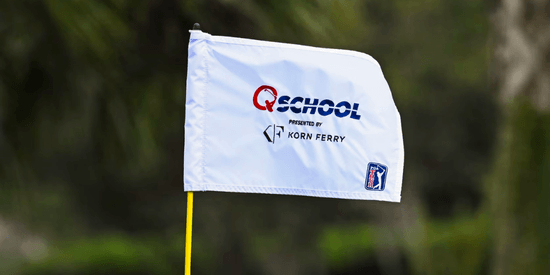2013 Preview: 10 storylines to watch this year
1/3/2013 | by Golfweek
Golfweek's Sean Martin examines the 10 storylines to follow in amateur golf this year
The odd-numbered years always provide a little added interest to the amateur golf
season because
of the race for Walker Cup spots. Throw in a centennial U.S. Amateur celebration and
the usual
major championships, and it promises to be another interesting year watching top
prospects
compete on the amateur circuit:
1. A centennial U.S. Amateur
The U.S. Amateur always highlights the summer schedule but the 2013 edition – scheduled for Aug. 12-18 at The Country Club in Brookline, Mass. – promises to be extra special. Most participants will remember this course as the site of the United States’ comeback at the 1999 Ryder Cup. The U.S. Amateur is being held there to commemorate an even more historic event: the 100- year anniversary of Francis Ouimet’s unlikely 1913 U.S. Open victory at The Country Club.
2. The Walker Cup
This biennial competition returns to the United States after Great Britain & Ireland’s 2011 upset. This year’s Walker Cup will be played Sept. 7-8 at National Golf Links of America, which hosted the first Walker Cup in 1922. The course was designed in 1911 by C.B. Macdonald and is No. 4 on Golfweek’s Best Classic Courses. National Golf Links is located in the Long Island town of Southampton, which also is home to Shinnecock Hills. The Walker Cup’s clandestine selection process has been the source of controversy and criticism, but there’s no denying that the event dominates the thoughts of American amateurs on odd-numbered years.
3. Decision time
This year marks the debut of the PGA Tour’s new qualifying format, which will undoubtedly have an impact on amateur golf, especially the U.S. Amateur and Walker Cup. The Web.com Tour Finals will replace Q-School as a source of PGA Tour cards in 2013. Amateur players looking to turn pro will have to decide if they want to turn pro immediately after the NCAA Championship, and try to earn PGA Tour status via sponsor exemptions, or wait until after the U.S. Amateur and Walker Cup. Players who choose the latter won’t have the opportunity to play the Web.com Tour Finals, so they’ll be relegated to Q-School, which will only offer Web.com Tour status for next season. This may influence more players to turn pro earlier in the summer. We’ll find out soon.
4. The majors
Amateurs are often part of the story at the Masters, U.S. Open and Open Championship. All eyes will be on a 14-year-old, China’s Tianlang Guan, at Augusta National, but a player from the older set also will be trying to make history. U.S. Mid-Am champ Nathan Smith will be making his fourth Masters appearance; he’s still trying to become the first reigning Mid-Am champ to make the cut.
U.S. Amateur champion Steven Fox, runner-up Michael Weaver and British Amateur champion Alan Dunbar hold invitations to the season’s first two majors. Washington senior Chris Williams is in both the U.S. Open and Open Championship. Williams earned those berths by winning the McCormack Medal as the No. 1 player in the R&A World Amateur Ranking. It will be interesting to see if Williams, a Washington senior, will use those exemptions or opt to turn pro immediately after the NCAA Championship.
T.J. Vogel, the U.S. Amateur Public Links champion, will join the amateurs at Augusta National, while several amateurs will earn U.S. Open tee times by virtue of sectional qualifying.
5. The race for the McCormack Medal
There have been various amateur-golf rankings over the years, but none have carried the significance of the R&A World Amateur Golf Ranking. The R&A’s ranking not only determines the fields for some of the world’s biggest amateur events, but also two major championships. The No. 1 player in the R&A rankings after the 2013 U.S. Amateur will win the Mark H. McCormack Medal and invitations to the 2014 U.S Open and Open Championship. The race for the McCormack Medal adds another storyline to the U.S. Amateur. Few people understand how the R&A rankings work, and that confusion has led to criticism, but their importance can no longer be denied.
6. Justin Thomas’ Walker Cup chase
Justin Thomas was on the sidelines when classmates Jordan Spieth and Patrick Rodgers played in the 2011 Walker Cup before beginning their college careers. Now Thomas, the reigning collegiate player of the year, is a favorite to earn a spot on the 2013 squad. A Walker Cup berth would leave Thomas, an Alabama sophomore, little to accomplish in the amateur game and start the speculation about when he would decide to turn pro. He has a chance this year to become the first back-to-back Haskins Award winner since Phil Mickelson.
7. Nathan Smith pursues history
Nathan Smith has two opportunities to make history this year. He’ll make his fourth Masters appearance in April, and will try to become the first reigning U.S. Mid-Am champ to make the Masters cut. Smith also will try to add to his record collection of U.S. Mid-Am titles. He’s already the first person to win the event four times (2003, ’09, ’10, ’11). He’s hard to bet against, having won three of the past four Mid-Ams, and making the semifinals in the other. He’s 22-1 in Mid-Am match play in the past four years. Smith also is seeking a third consecutive Walker Cup berth. It seems unlikely the USGA will leave a four-time USGA champ off the team.
8. What about the kids?
Three incoming freshmen have been a part of the past three U.S. Walker Cup squads (Rickie Fowler, 2007; Jordan Spieth, 2011; Patrick Rodgers, 2011). Jim Liu was the only high schooler invited to the recent 16-man Walker Cup practice session. Beau Hossler’s U.S. Open performance has him on the Walker Cup selectors’ radar, as well (Hossler is scheduled to start at Texas in January, but this is actually his senior year of high school). It’s become common for top high-school seniors to spend the summer before college playing amateur events instead of spending one last summer on the junior circuit. This makes it likely some incoming college freshman will put himself in the running for a Walker Cup spot.
9. What’s next for Asia-Pacific Amateur?
The Asia-Pacific Amateur is little more than three years old, but it has already introduced us to some promising young talents. Hideki Matsuyama, the 2010 and 2011 champion, made the cut in the past two Masters and has already won on the Japan Tour. He’s No. 127 in the Official World Golf Ranking because of his success on the Japan Tour. The 2012 Asia-Pacific Amateur allowed 14- year-old Tianlang Guan to earn a Masters invitation. The next Asia-Pacific Amateur will return to Guan’s home country of China, where the inaugural Asia-Pacific Amateur was played in 2009. It’s all but guaranteed we’ll be introduced to a player we otherwise never would have met. That’s what makes this tournament great.
10. Good news, Bears
Sixteen players recently took part in a practice session for the Walker Cup. One quarter of the participants were from one college team: Cal. The Bears’ Michael Weaver and Brandon Hagy, who made up half of the semifinalists at the 2012 U.S. Amateur, were there with teammates Michael Kim, currently No. 2 in the Golfweek/Sagarin College Rankings, and Max Homa. There are only 10 spots on the United States Walker Cup team. It seems unlikely that 40 percent of them will go to the members of one college team, but it’s not impossible. The 2009 Walker Cup team featured three teammates: Rickie Fowler, Morgan Hoffmann and Peter Uihlein of Oklahoma State.
1. A centennial U.S. Amateur
The U.S. Amateur always highlights the summer schedule but the 2013 edition – scheduled for Aug. 12-18 at The Country Club in Brookline, Mass. – promises to be extra special. Most participants will remember this course as the site of the United States’ comeback at the 1999 Ryder Cup. The U.S. Amateur is being held there to commemorate an even more historic event: the 100- year anniversary of Francis Ouimet’s unlikely 1913 U.S. Open victory at The Country Club.
2. The Walker Cup
This biennial competition returns to the United States after Great Britain & Ireland’s 2011 upset. This year’s Walker Cup will be played Sept. 7-8 at National Golf Links of America, which hosted the first Walker Cup in 1922. The course was designed in 1911 by C.B. Macdonald and is No. 4 on Golfweek’s Best Classic Courses. National Golf Links is located in the Long Island town of Southampton, which also is home to Shinnecock Hills. The Walker Cup’s clandestine selection process has been the source of controversy and criticism, but there’s no denying that the event dominates the thoughts of American amateurs on odd-numbered years.
3. Decision time
This year marks the debut of the PGA Tour’s new qualifying format, which will undoubtedly have an impact on amateur golf, especially the U.S. Amateur and Walker Cup. The Web.com Tour Finals will replace Q-School as a source of PGA Tour cards in 2013. Amateur players looking to turn pro will have to decide if they want to turn pro immediately after the NCAA Championship, and try to earn PGA Tour status via sponsor exemptions, or wait until after the U.S. Amateur and Walker Cup. Players who choose the latter won’t have the opportunity to play the Web.com Tour Finals, so they’ll be relegated to Q-School, which will only offer Web.com Tour status for next season. This may influence more players to turn pro earlier in the summer. We’ll find out soon.
4. The majors
Amateurs are often part of the story at the Masters, U.S. Open and Open Championship. All eyes will be on a 14-year-old, China’s Tianlang Guan, at Augusta National, but a player from the older set also will be trying to make history. U.S. Mid-Am champ Nathan Smith will be making his fourth Masters appearance; he’s still trying to become the first reigning Mid-Am champ to make the cut.
U.S. Amateur champion Steven Fox, runner-up Michael Weaver and British Amateur champion Alan Dunbar hold invitations to the season’s first two majors. Washington senior Chris Williams is in both the U.S. Open and Open Championship. Williams earned those berths by winning the McCormack Medal as the No. 1 player in the R&A World Amateur Ranking. It will be interesting to see if Williams, a Washington senior, will use those exemptions or opt to turn pro immediately after the NCAA Championship.
T.J. Vogel, the U.S. Amateur Public Links champion, will join the amateurs at Augusta National, while several amateurs will earn U.S. Open tee times by virtue of sectional qualifying.
5. The race for the McCormack Medal
There have been various amateur-golf rankings over the years, but none have carried the significance of the R&A World Amateur Golf Ranking. The R&A’s ranking not only determines the fields for some of the world’s biggest amateur events, but also two major championships. The No. 1 player in the R&A rankings after the 2013 U.S. Amateur will win the Mark H. McCormack Medal and invitations to the 2014 U.S Open and Open Championship. The race for the McCormack Medal adds another storyline to the U.S. Amateur. Few people understand how the R&A rankings work, and that confusion has led to criticism, but their importance can no longer be denied.
6. Justin Thomas’ Walker Cup chase
Justin Thomas was on the sidelines when classmates Jordan Spieth and Patrick Rodgers played in the 2011 Walker Cup before beginning their college careers. Now Thomas, the reigning collegiate player of the year, is a favorite to earn a spot on the 2013 squad. A Walker Cup berth would leave Thomas, an Alabama sophomore, little to accomplish in the amateur game and start the speculation about when he would decide to turn pro. He has a chance this year to become the first back-to-back Haskins Award winner since Phil Mickelson.
7. Nathan Smith pursues history
Nathan Smith has two opportunities to make history this year. He’ll make his fourth Masters appearance in April, and will try to become the first reigning U.S. Mid-Am champ to make the Masters cut. Smith also will try to add to his record collection of U.S. Mid-Am titles. He’s already the first person to win the event four times (2003, ’09, ’10, ’11). He’s hard to bet against, having won three of the past four Mid-Ams, and making the semifinals in the other. He’s 22-1 in Mid-Am match play in the past four years. Smith also is seeking a third consecutive Walker Cup berth. It seems unlikely the USGA will leave a four-time USGA champ off the team.
8. What about the kids?
Three incoming freshmen have been a part of the past three U.S. Walker Cup squads (Rickie Fowler, 2007; Jordan Spieth, 2011; Patrick Rodgers, 2011). Jim Liu was the only high schooler invited to the recent 16-man Walker Cup practice session. Beau Hossler’s U.S. Open performance has him on the Walker Cup selectors’ radar, as well (Hossler is scheduled to start at Texas in January, but this is actually his senior year of high school). It’s become common for top high-school seniors to spend the summer before college playing amateur events instead of spending one last summer on the junior circuit. This makes it likely some incoming college freshman will put himself in the running for a Walker Cup spot.
9. What’s next for Asia-Pacific Amateur?
The Asia-Pacific Amateur is little more than three years old, but it has already introduced us to some promising young talents. Hideki Matsuyama, the 2010 and 2011 champion, made the cut in the past two Masters and has already won on the Japan Tour. He’s No. 127 in the Official World Golf Ranking because of his success on the Japan Tour. The 2012 Asia-Pacific Amateur allowed 14- year-old Tianlang Guan to earn a Masters invitation. The next Asia-Pacific Amateur will return to Guan’s home country of China, where the inaugural Asia-Pacific Amateur was played in 2009. It’s all but guaranteed we’ll be introduced to a player we otherwise never would have met. That’s what makes this tournament great.
10. Good news, Bears
Sixteen players recently took part in a practice session for the Walker Cup. One quarter of the participants were from one college team: Cal. The Bears’ Michael Weaver and Brandon Hagy, who made up half of the semifinalists at the 2012 U.S. Amateur, were there with teammates Michael Kim, currently No. 2 in the Golfweek/Sagarin College Rankings, and Max Homa. There are only 10 spots on the United States Walker Cup team. It seems unlikely that 40 percent of them will go to the members of one college team, but it’s not impossible. The 2009 Walker Cup team featured three teammates: Rickie Fowler, Morgan Hoffmann and Peter Uihlein of Oklahoma State.
Most Popular Articles

2025 PGA TOUR Q-School Guide: Sites, Scores, and Who Advanced
Dec 5, 2025Second Stage is complete and Final Stage awaits at Sawgrass — follow every Q-School leaderboard and the players still chasing
2025 LPGA TOUR Q-Series: Final Qualifying Stage FINAL SCORING
Dec 8, 2025Helen Briem earns medalist honors, 31 players headed to the LPGA next year
Australian Open at Royal Melbourne: Preview, amateur bios, and how to watch
Nov 30, 2025Rory McIlroy headlines one of the championship's top fields in years - at least four amateurs will have their chance at glory
Luke Ringkamp Cruises to Rolex Tournament of Champions Title at TPC San Antonio
Nov 26, 2025One week after committing to Pepperdine, Luke Ringkamp won the Rolex Tournament of Champions by nine shots.Inside Gil Hanse’s Restoration of Baltusrol’s Upper Course: A Return to Tillinghast’s
Dec 11, 2025Renowned architect Gil Hanse reveals how he brought Baltusrol’s Upper Course back to life by honoring A.W. Tillinghast’s originalLoading latest news...
